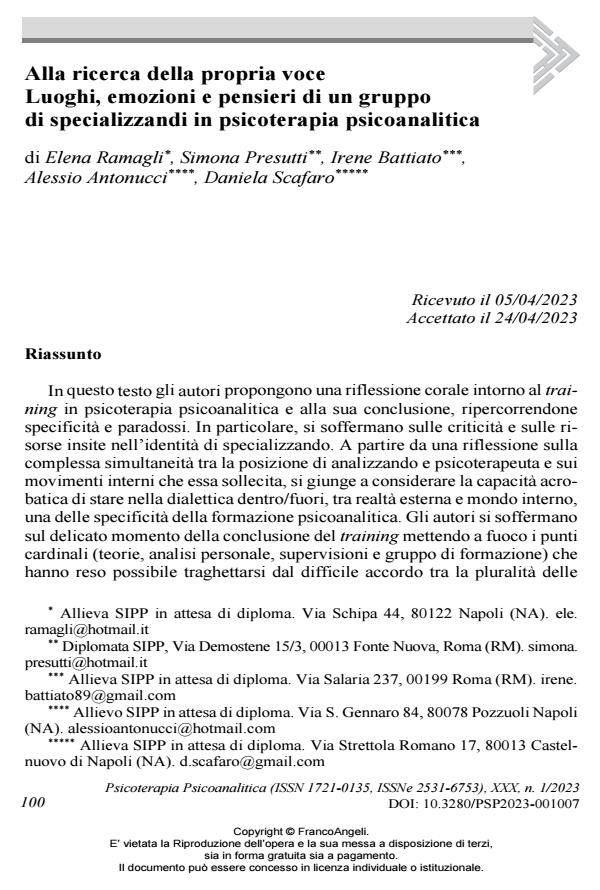Looking for one’s own voice. Places, emotions and thoughts of a group of psychoanalytic psychotherapy trainees
Journal title PSICOTERAPIA PSICOANALITICA
Author/s Elena Ramagli, Simona Presutti, Irene Battiato, Alessio Antonucci, Daniela Scafaro
Publishing Year 2023 Issue 2023/1 Language Italian
Pages 8 P. 100-107 File size 201 KB
DOI 10.3280/PSP2023-001007
DOI is like a bar code for intellectual property: to have more infomation
click here
Below, you can see the article first page
If you want to buy this article in PDF format, you can do it, following the instructions to buy download credits

FrancoAngeli is member of Publishers International Linking Association, Inc (PILA), a not-for-profit association which run the CrossRef service enabling links to and from online scholarly content.
In this paper, the authors offer a reflection on training in psychoan-alytic psychotherapy and its conclusion, pointing out its peculiarities and paradoxes. They dwell on the critical issues and resources inherent in the trainee identity. Beginning with a reflection on the complex sim-ultaneity between the position of analyzand and psychotherapist and the internal movements it prompts, they come to consider the acrobatic ability to stand in the dialectic inside/outside, between external reality and inner world, one of the specificities of psychoanalytic training. Fi-nally, the authors reflect on the delicate moment of the training’s con-clusion by focusing on the cardinal points (theories, personal analysis, supervision and training group) that made it possible to move from the difficult agreement between the plurality of voices accompanying the training process, to the discovery of one’s own authentic voice played and valued in harmonious melody.
Keywords: training, group, threshold, inner setting
- Coltart N. (1993). Come sopravvivere da psicoterapeuta. Torino: Utet, 2012.
- Ferruta A. (2013). Il primo colloquio e il dialogo analitico-giornata in onore di Enzo Morpurgo. -- Testo disponibile al sito: https://www.spiweb.it/ eventi/enzo-morpurgo-dialogo-analitico-e-dialogo-mondano 29/03/2023.
- Freud S. (1912). Consigli al medico nel trattamento psicoanalitico. OSF, 6.
- Freud S. (1926). Il problema dell’analisi condotta dai non medici. Conversazione con un interlocutore imparziale. OSF, 10.
- Illiano F., Riefolo G. (2014). La terapia psicoanalitica per pazienti psicotici. In Neri C., Patalano R., Salemme P. (a cura di). Fare gruppo nelle istituzioni psichiatriche. Milano: Franco Angeli, pp. 96-102.
- Margherita G.V. (2009). Narrazione e rappresentazione nella psicodinamica di gruppo. Teorie e tecniche. Milano: Franco Angeli.
- Perini M. (2015). L’organizzazione nascosta. Dinamiche inconsce e zone d’ombra nelle moderne organizzazioni. Milano: Franco Angeli.
- Sandler J. (1987). Proiezione, identificazione, identificazione proiettiva. Torino: Bollati Boringhieri, 1988.
- Stoppa F. (2007). La prima curva dopo il paradiso. Roma: Borla.
- Winnicott D.W. (1971). Gioco e realtà. Roma: Armando, 2020.
Elena Ramagli, Simona Presutti, Irene Battiato, Alessio Antonucci, Daniela Scafaro, Alla ricerca della propria voce Luoghi, emozioni e pensieri di un gruppo di specializzandi in psicoterapia psicoanalitica in "PSICOTERAPIA PSICOANALITICA" 1/2023, pp 100-107, DOI: 10.3280/PSP2023-001007